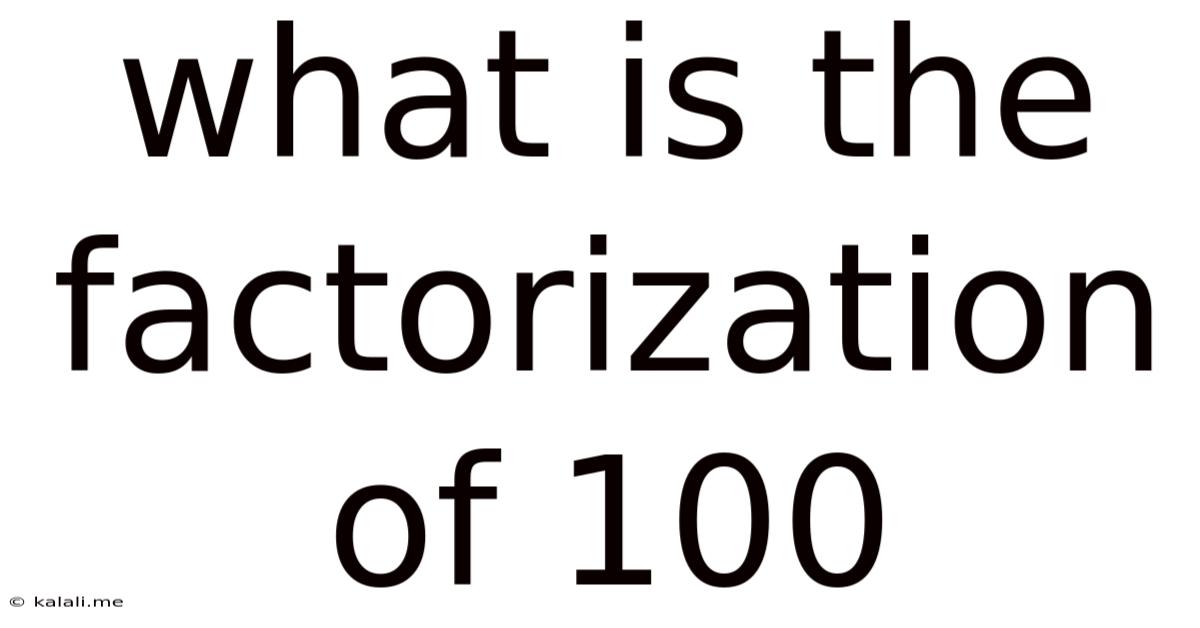What Is The Factorization Of 100
Kalali
Jun 11, 2025 · 3 min read

Table of Contents
What is the Factorization of 100? A Comprehensive Guide
Finding the factorization of a number is a fundamental concept in mathematics, crucial for understanding number theory and simplifying complex calculations. This article will explore the factorization of 100, explaining the process and demonstrating its applications. Understanding prime factorization is key to many mathematical concepts, including simplifying fractions and finding the greatest common divisor (GCD) and least common multiple (LCM) of numbers.
What is Factorization?
Factorization, also known as factoring, is the process of breaking down a number into smaller numbers that, when multiplied together, give the original number. These smaller numbers are called factors. For example, the factors of 12 are 1, 2, 3, 4, 6, and 12, because 1 x 12 = 12, 2 x 6 = 12, and 3 x 4 = 12.
Prime Factorization: The Building Blocks
Prime factorization is a special type of factorization where a number is broken down into its prime factors. A prime number is a whole number greater than 1 that has only two divisors: 1 and itself. Examples of prime numbers include 2, 3, 5, 7, 11, and so on. Prime factorization is unique; every number greater than 1 can be expressed as a product of prime numbers in only one way (ignoring the order of the factors). This uniqueness is a cornerstone of number theory.
Factorizing 100
Let's find the prime factorization of 100. We can start by finding any two factors of 100. A simple starting point is 10 and 10:
100 = 10 x 10
Now, let's break down each of these factors further. 10 can be factored as 2 x 5. Therefore:
100 = (2 x 5) x (2 x 5)
Combining these, we get the prime factorization of 100:
100 = 2 x 2 x 5 x 5 or 2² x 5²
This means that 100 is composed of two factors of 2 and two factors of 5. This representation is useful in various mathematical operations.
Applications of Factorization
Understanding the factorization of numbers, especially prime factorization, has several practical applications in mathematics and beyond:
-
Simplifying Fractions: Finding the greatest common divisor (GCD) of the numerator and denominator of a fraction allows you to simplify the fraction to its lowest terms. Prime factorization is often the most efficient method for finding the GCD.
-
Solving Equations: Factorization is a crucial technique in solving algebraic equations, particularly quadratic equations.
-
Cryptography: Prime factorization plays a vital role in modern cryptography, forming the basis of many encryption algorithms. The difficulty of factoring large numbers into their prime components is what makes these encryption methods secure.
-
Number Theory: Prime factorization is fundamental to many areas of number theory, including modular arithmetic and the study of prime number distributions.
Conclusion
The factorization of 100, expressed as 2² x 5², is more than just a simple mathematical exercise. It highlights the importance of prime factorization and its broad applications across various mathematical fields. By understanding this fundamental concept, you gain a deeper understanding of numbers and their properties, empowering you to tackle more complex mathematical problems with greater ease and efficiency.
Latest Posts
Latest Posts
-
Is Keri Russell Related To Kurt Russell
Jul 02, 2025
-
What Is Half Of 1 4 Teaspoon
Jul 02, 2025
-
How Many Cups In A Pound Of Hamburger Meat
Jul 02, 2025
-
Imagery Or Figurative Language From Romeo And Juliet
Jul 02, 2025
-
What Is A Quarter Of A Million
Jul 02, 2025
Related Post
Thank you for visiting our website which covers about What Is The Factorization Of 100 . We hope the information provided has been useful to you. Feel free to contact us if you have any questions or need further assistance. See you next time and don't miss to bookmark.